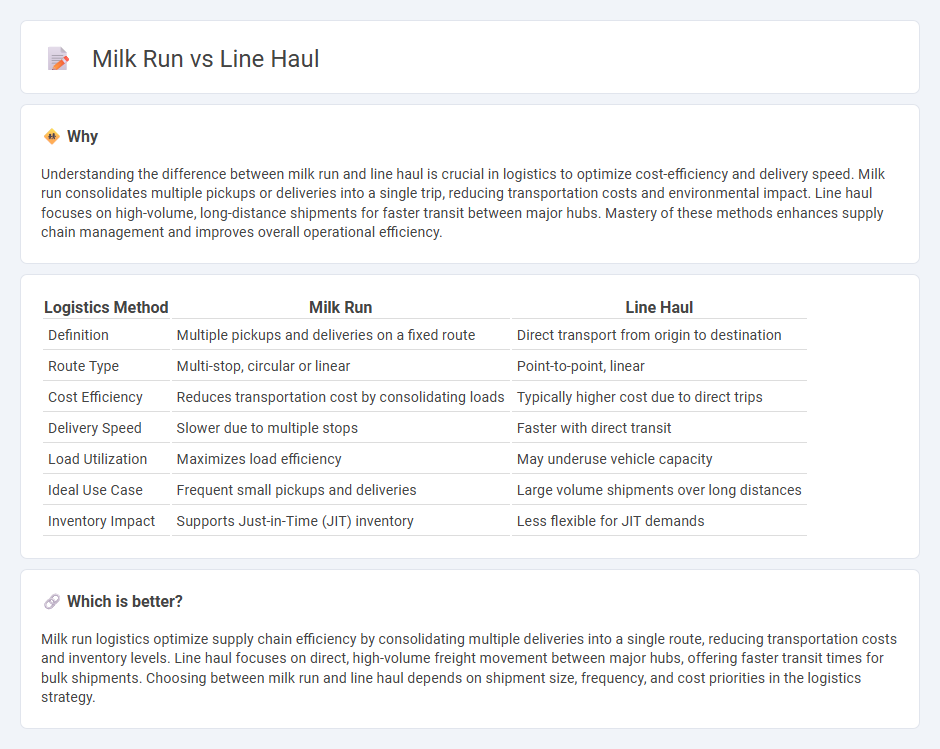
Milk run logistics optimizes delivery by collecting goods from multiple suppliers in a single trip, reducing transportation costs and improving efficiency. Line haul focuses on long-distance movement of bulk goods directly between warehouses or distribution centers, ensuring timely large-scale shipments. Discover more about how each method enhances supply chain performance.
Why it is important
Understanding the difference between milk run and line haul is crucial in logistics to optimize cost-efficiency and delivery speed. Milk run consolidates multiple pickups or deliveries into a single trip, reducing transportation costs and environmental impact. Line haul focuses on high-volume, long-distance shipments for faster transit between major hubs. Mastery of these methods enhances supply chain management and improves overall operational efficiency.
Comparison Table
| Logistics Method | Milk Run | Line Haul |
|---|---|---|
| Definition | Multiple pickups and deliveries on a fixed route | Direct transport from origin to destination |
| Route Type | Multi-stop, circular or linear | Point-to-point, linear |
| Cost Efficiency | Reduces transportation cost by consolidating loads | Typically higher cost due to direct trips |
| Delivery Speed | Slower due to multiple stops | Faster with direct transit |
| Load Utilization | Maximizes load efficiency | May underuse vehicle capacity |
| Ideal Use Case | Frequent small pickups and deliveries | Large volume shipments over long distances |
| Inventory Impact | Supports Just-in-Time (JIT) inventory | Less flexible for JIT demands |
Which is better?
Milk run logistics optimize supply chain efficiency by consolidating multiple deliveries into a single route, reducing transportation costs and inventory levels. Line haul focuses on direct, high-volume freight movement between major hubs, offering faster transit times for bulk shipments. Choosing between milk run and line haul depends on shipment size, frequency, and cost priorities in the logistics strategy.
Connection
Milk run and line haul are integral components of an efficient logistics strategy, ensuring timely and cost-effective transportation of goods. Milk run optimizes local deliveries by consolidating shipments from multiple suppliers, while line haul manages long-distance transport between distribution centers or warehouses. Their connected operation reduces transportation costs, minimizes inventory levels, and improves supply chain reliability.
Key Terms
Transportation Mode
Line haul transportation involves moving goods directly between large hubs or distribution centers, typically over long distances, using trucks, rail, or air freight for efficiency and speed. Milk run transportation optimizes route efficiency by collecting and delivering smaller loads from multiple suppliers or destinations in a single trip, reducing costs and environmental impact. Explore the differences between line haul and milk run transportation modes to optimize your logistics strategy.
Route Optimization
Line haul involves direct point-to-point transportation, focusing on long-distance routes for moving large volumes between major hubs, optimizing speed and cost-efficiency. Milk run routes consolidate multiple pickups and deliveries in a single trip, enhancing route optimization by reducing empty miles and improving load utilization in local or regional distribution. Explore detailed strategies to determine the best approach for your supply chain efficiency and cost management.
Load Consolidation
Load consolidation in line haul logistics involves transporting large shipments directly between major distribution centers, maximizing truck capacity for cost efficiency and faster transit times. In contrast, a milk run strategy consolidates smaller shipments from multiple suppliers or locations into a single vehicle route, optimizing delivery frequency and reducing inventory holding costs. Explore detailed comparisons to understand how load consolidation impacts your supply chain efficiency.
Source and External Links
Line Haul Meaning in Trucking - FreightRun.com - Line haul refers to the movement of goods over long distances between major hubs using various transport modes like trucks, trains, cargo planes, or ships depending on the cargo type and urgency, with types including ground, air, and sea line haul.
How Line Haul Transportation Can Benefit Your Business - Line haul transportation moves goods long distances cost-effectively and quickly, often involving consolidation at distribution centers and real-time route optimization to improve speed and service quality.
What is a Line Haul? (How To Become and Responsibilities) - Indeed - A line haul driver operates commercial vehicles, usually tractor-trailers, to transport goods on shorter routes between locations, with responsibilities including loading, unloading, route planning, and vehicle maintenance.
 dowidth.com
dowidth.com